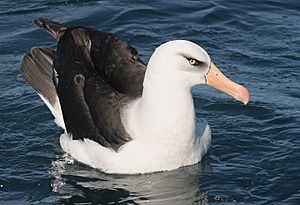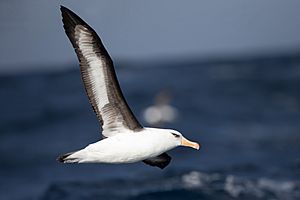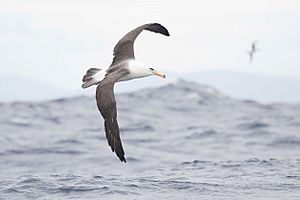Campbell albatross facts for kids
Quick facts for kids Campbell albatross |
|
|---|---|
 |
|
 |
|
| Conservation status | |
| Scientific classification | |
| Genus: |
Thalassarche
|
| Species: |
impavida
|
| Synonyms | |
|
|
The Campbell albatross or Campbell mollymawk (Thalassarche impavida) is a medium-sized seabird. It is part of the albatross family. This bird breeds only on Campbell Island and a small nearby islet called Jeanette Marie. These islands are a small group belonging to New Zealand in the South Pacific. Some people think it is a type of black-browed albatross. The Campbell albatross is a black and white bird with a pale yellow eye.
Contents
What is a Campbell Albatross?
Mollymawks are a kind of albatross. They belong to a group of seabirds called Procellariiformes. This group also includes birds like shearwaters and petrels. These birds share some special features.
First, they have unique nose tubes called naricorns on their upper beak. Albatross nostrils are on the sides of their beak. Their beaks are also special, made of several strong plates.
These birds can also make a special stomach oil. This oil is stored in their stomach. They use it to protect themselves from predators. It is also a rich food source for their chicks. Adults use it for energy during their long flights.
Finally, they have a salt gland above their nose. This gland helps them remove salt from their bodies. This is important because they drink a lot of ocean water. The gland releases a salty liquid from their nose.
In 1998, some scientists suggested that the Campbell albatross should be its own species. Before that, it was often seen as a type of black-browed albatross. Many experts now agree it is a separate species.
What Does a Campbell Albatross Look Like?
The Campbell albatross weighs about 3.2 kilograms (7 pounds). It is about 88 centimeters (35 inches) long. Adult Campbell albatrosses look very much like the black-browed albatross. The main difference is their eye color.
This albatross has a white head, neck, and belly. Its upper wings, back, and tail are black. The underside of its wings is white with wide black edges. It has a black triangle shape around its eye that reaches its beak. The beak is yellow with an orange tip. They also have a pale yellow eye.
Young Campbell albatrosses look a bit different. They have a brown-grey beak with a black tip. Their eyes are dark, and they have less black on the underside of their wings. These birds can live for over 50 years. However, the average life expectancy is often listed as 28 years because they have not been studied as much as other albatrosses.
Where Do Campbell Albatrosses Live?
The Campbell albatross breeds on the northern and western coasts of Campbell Island. They also breed on the small islet of Jeanette Marie.
When they are breeding, they search for food from South Island and the Chatham Rise all the way to the Ross Sea. Young birds and those not breeding travel through waters near southern Australia, the Tasman Sea, and the southwestern Pacific Ocean.
In 1997, there were about 24,600 breeding pairs of Campbell albatrosses. The total population was around 49,000 birds. Their numbers were increasing by about 1.8% each year.
How Do Campbell Albatrosses Behave?
What Do They Eat?
The Campbell albatross eats many things. They feed on fish, squid, and small sea creatures called crustacea. They also eat dead animals and jelly-like sea organisms.
How Do They Reproduce?
Breeding birds like to build their nests on ledges and steep slopes. These areas are usually covered with low grass or mud. They start breeding when they are about 10 years old. About 66% of their breeding attempts are successful.
Adult albatrosses return to their breeding colony in early August. They start laying their single egg in late September. The egg is incubated (kept warm) for about 70 days. The chicks leave the nest and learn to fly (fledge) about 130 days after hatching.
How Are Campbell Albatrosses Protected?
The IUCN lists the Campbell albatross as a vulnerable species. This means they are at risk. They are vulnerable because they only breed in a few places. The most recent count in 1997 found 24,600 breeding pairs. Between 1992 and 1997, the number of birds in studied colonies was growing by 1.8% each year. About 94.5% of adult birds survive each year.
The biggest danger to this species comes from fishing. Both longline fishing and trawlers can accidentally catch these birds.
Good news for the albatrosses is that all wild sheep on Campbell Island were removed by 1991. Rats and cats, which could harm the birds, were also removed by 2001. Scientists are still studying these birds to help protect them.
See also
 In Spanish: Albatros de Campbell para niños
In Spanish: Albatros de Campbell para niños




